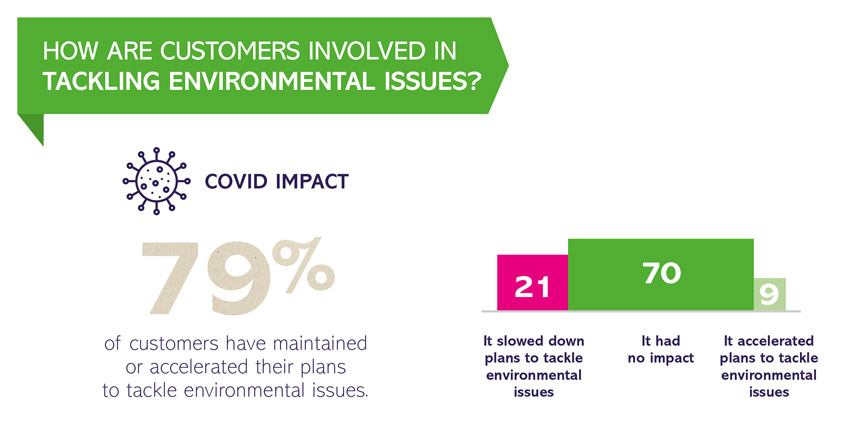Top inspirations
for innovative
eco-friendly packaging
20 PAGES OF TIPS, BEST PRACTICES
& CASE STUDIES
Ambalajul ecologic ia în considerare impactul asupra mediului pe care întregul său ciclu de viață și urmărește să minimizeze efectele nocive asupra sănătății umane și asupra mediului înconjurător. Reducerea dimensiunii și a greutății ambalajelor și expedierea în cutii cu dimensiunile potrivite este punctul cheie al unei strategii de ambalare sustenabile, alături de alegerea materialelor prietenoase cu mediul. Inovațiile permit crearea de ambalaje durabile, cu greutăți optimizate, care eficientizează lanțul de aprovizionare. Trecerea de la materialele convenționale la cele ecologice și reducerea dimensiunilor ambalajelor vă permite să deveniți mai verzi.
Conform sontajului Antalis asupra clienților de mediu realizat prin IFOP (martie 2021), 79% dintre clienții Antalis consideră important sau foarte important ca produsele de ambalare să fie prietenoase cu mediul. 62% sunt dispuși să plătească mai mult pentru produse de ambalare ecologice, tendință care este în creștere în viitor, dat fiind faptul că companiile implicate în CSR sunt în fruntea curbei.
Chiar dacă prețul rămâne criteriul cheie de cumpărare pentru clienții Antalis, mediul înconjurător ocupă locul al doilea ca importanță, ceea ce arată potențialul acestui aspect pentru clienți. Aceștia îl plasează chiar la același nivel cu funcția primară a unui ambalaj, cum este funcționalitatea sa!

Consumatorii sunt și mai conștienți de mediu. Aceștia cer companiilor să găsească soluții sustenabile, care diminueze deșeurile și să reducă amprenta de carbon. 42% dinte clienți susțin că ambalajele realizate din materiale reciclate și durabile sunt esențiale în crearea obiceiurilor de cumpărare (Globalwebindex 2019).
În plus, autoritățile de reglementare, ONG-urile și clienții pun presiune pe companii pentru a găsi soluții sustenabile pentru a atenua epuizarea resurselor și schimbările climatice. 55% dintre respondenții din S.U.A. (McKinsey & company survey) în octombrie 2020 au raportat că sunt extrem de preocupați sau foarte preocupați ca produsele de ambalare să fie prietenoase cu mediul, așadar consumatorii își păstrează focusul asupra acestui aspect. Deoarece clienții nu se concentrează numai asupra unui singur domeniu, companiile care acționează în privința sustenabilității trebuie să adreseze o gamă largă de preocupări. În toate segmentele de utilizare finală, 60%, până la 70%, dintre consumatori susțin că ar plăti mai mult pentru ambalaje durabile. 52% dintre consumatori au spus că ar cumpăra mai multe produse de ambalare sustenabile dacă acestea ar costa mai puțin decât variantele convenționale de ambalare.
Criteriile de bază de cumpărare și rovocările de mediu sunt legate acum de abordarea comercială, deaorece spațiul gol și materialele de ambalare în exces frustrează consumatorii și creează o experiență de brand neplăcută. Mediul înconjurător are un impact major, în special, de când a început pandemia de Covid-19. De exemplu, 100% din cutiile pentru expediere de la Sezane sunt acum realizate din carton reciclat și pot fi returnate sau folosite ca decorațiuni, în case. Retailerul online francez, Sezane, se află, de asemenea, în proces de eficientizare a cutiilor, prin eliminarea etichetelor nenecesare și a ambalării excesive și prin adaptarea dimensiunii și a formei pentru a se potrivi mai bine cu produsele pentru care au fost realizate.

Ca urmare a pandemiei, importanța soluțiilor de ambalare durabile devine din ce în ce mai greu de ignorat. Odată cu căderea comerțului cu amănuntul neesențial, schimbarea stilului de viață include mai multe livrări la domiciliu și mai multe ambalaje de sortat și reciclat. În același timp, consumatorii au nevoie de o experiență de despachetare satisfăcătoare, deoarece aceștia fac cumpărături acasă. Etichetele trebuie să corespundă acestor așteprări antagonice prin găsirea soluțiilor de ambalare inteligente și prietenoase cu mediul.
Mai conștienți de problemele de mediu legate de deșeuri și ambalare, peste 2/3 dintre clienți spun că ar plăti mai mult pe ambalaje care au un impact redus asupra mediului. De asemenea, oamenii reciclează mai mult atunci când știu ce devin deșeurile reciclabile, conform Asociației American Marketing. În Marea Britanie, 50% dintre consumatori au aderat deja la branduri care acordă atenție ambalării. Prin urmare, este important ca brandurile de e-Commerce inovatoare să implice clienții și așteptările lor în planul de business.
Proiectarea și procesarea unui ambalaj ecologic nu este suficientă. Pentru ca acesta să fie pe deplin durabil, trebuie luat în considerare și sfârșitul vieții sale. Acesta este motivul pentru care mărcile trebuie să se gndească reciclarea eficientă a produselor lor. Reciclarea Nespresso a început în Marea Britanie, acum 10 ani. Clienților le sunt oferite diverse opțiuni pentru colectarea capsulelor și pentru separarea cafelei de aluminiu pentru a doua lor viață. Ambalajul este reciclabil atunci când poate fi colectat, procesat și returnat pentru a fi folosit sub formă de materii prime sau mărfuri. Reciclarea ambalajelor depinde de natura și de compoziția acestora.

Concentrarea atenției pe materiale flexibile sau monomateriale, precum și pe alternative biodegradabile, pe bază de plante sau alte variante alternative ecologice, poate ajuta la integrarea ambalajelor într-un sistem circular de aprovizionare. Aproape orice material este biodegradabil , însă unele dintre ele se degradează mai lent, pe parcursul mai multor decenii sau, chiar, secole, și este posibil ca acestea să nu fie ecologice.
Așadar, dacă doriți ca mabalajul dvs. să își încheie ciclul de viață într-o maieră ecologică, așa cum a început, aflați mai multe informații precise despre reciclare de la experții CSR pentru a vă asigura că ambalajele dvs. sunt colectate eficient, trimise către facilități de recuperare pentru a fi sortate, curățate și procesate în materiale care pot fi folosite în producție, ca în cazul materiilor prime.
Soluțiile de ambalare ecologice și inteligente Eco-friendly and oferă o experiență mai bună clienților și reduc amprenta de carbon a ambalajelor, expedierilor și livrărilor pentru brandurile convenționale și pentru retailerii de e-Commerce. Având în vedere creșterea gradului de conștientizare, în rândul companiilor și al clienților, față de importanța promovării unei dezvoltări sustenabile prin ambalaje verzi alternative, cheia succesului este acum educarea consumatorilor cu privire la modul în care se utilizează și se elimină ambalajele, astfel încât să se realizeze trecerea către ambalarea responsabilă și fără frustrări.
________________________________
Surse:
1- Sondaj realizat de McKinseay în perioada 14 -22 aprilie 2020, pe 2,004 consumatori nemți și britanici cu vârste de la 18 ani în sus
2 - https://www.sciencedaily.com/releases/2019/05/190516103712.htm
3 - Sondaj realizat de McKinseay în perioada 14 -22 aprilie 2020, pe 2,004 consumatori nemți și britanici cu vârste de la 18 ani în sus
20 PAGES OF TIPS, BEST PRACTICES
& CASE STUDIES
